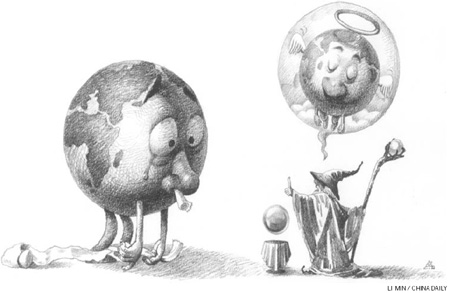-
-
China Daily E-paper
Op-Ed Contributors
Factual factors in weird weather
By John E. Coulter (China Daily)
Updated: 2010-05-06 08:02
 |
Large Medium Small |

Editor's note: The global climate is changing now but people shouldn't believe rumors that claim the world will end in 2012.
Will the world end in 2012? asks a young blogger. No, but rumors about the end of the world in 2012 will, comes a sharp reply. The Newsweek's May 2, 2009, issue carried an article that went to the root of the source of the rumor: the Mayan calendar (actually calendars called "long count") which according to the Gregorian calendar ends in 2012.
The end-of the world hype was created ostensibly to promote the Hollywood science fiction film, 2012, a saga of oceans swallowing up mountains. Search engine Baidu now has a huge number of sensational blog websites for "End of the World in 2012" and "Climate Change Rumors" (in Chinese) with mainly young people blogging a mix of naive and witty responses.
|
||||
With the world economy squeezing the global environment on which it so desperately depends, human beings have good cause to ask themselves: Are we exacerbating global warming? The answer is "partly yes". Last year, we used 20 billion tons of fossil fuel, emitting 29 billion tons of carbon dioxide into the air. This tonnage is rising faster each year. Mixed with other pollutant gases and with ash particles, it acts like a cover for greenhouse.
Apart from the basic greenhouse effect, the pollutant emissions probably cause other changes, too. The sunlight that reaches oceans, seas, lakes and other water bodies and evaporates water now has to pass through a filter of pollutant gases. The result: Not enough water evaporates to form into clouds leading to drought in many places.
The air on the day side of the globe heats up and expands, while on night side it cools down and shrinks. The effect is like a dual chamber heart pump. When we pollute the fluid circulation to the extent we have, it results in extreme swings of temperature and precipitation that can be likened to giving the natural cycle wild palpitations, maybe up to a tipping point.













